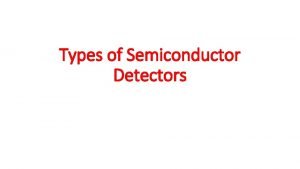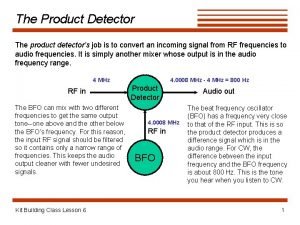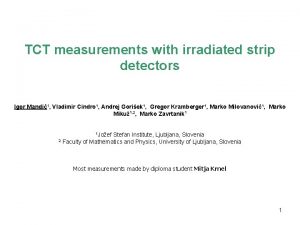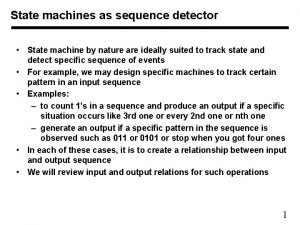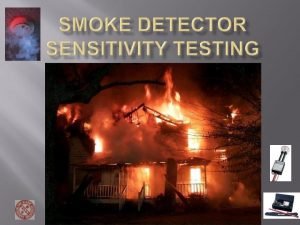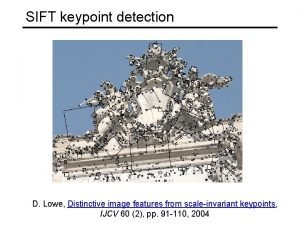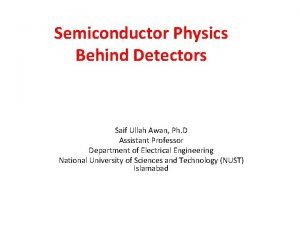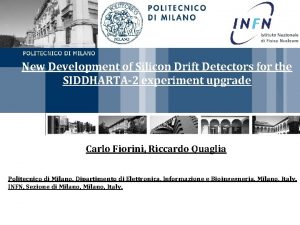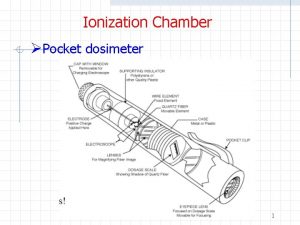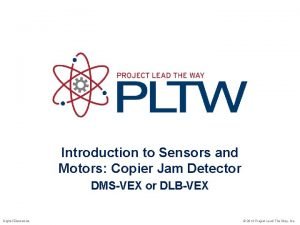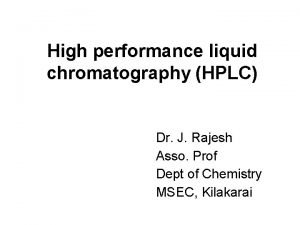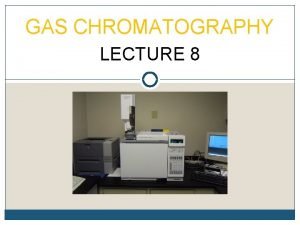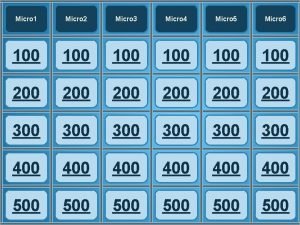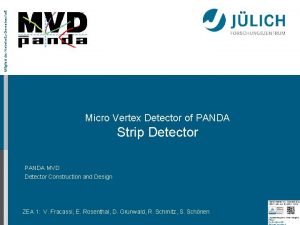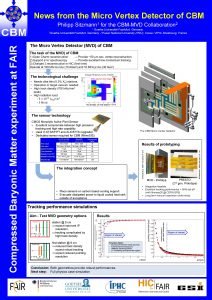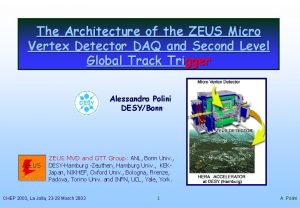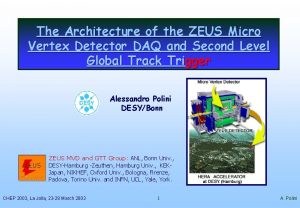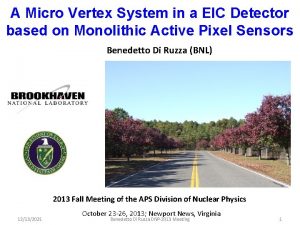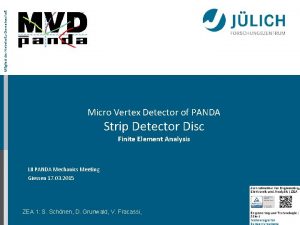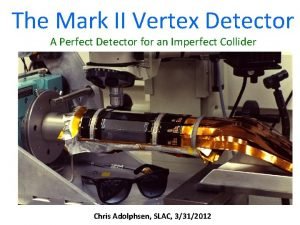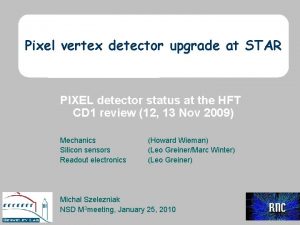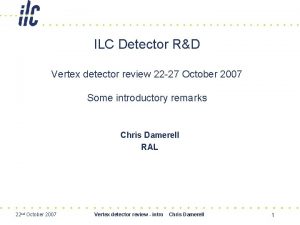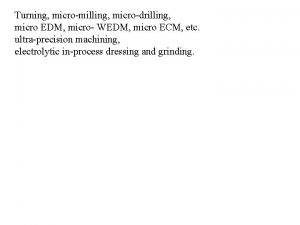Design of the Micro Vertex Detector of the







![Choice of technology [after M. Deveaux, Ph. D Thesis ] CBM (105 coll/s) Hybrid Choice of technology [after M. Deveaux, Ph. D Thesis ] CBM (105 coll/s) Hybrid](https://slidetodoc.com/presentation_image_h/25e967674fedceec2ce750f69aa6e2cb/image-8.jpg)











- Slides: 19

Design of the Micro Vertex Detector of the CBM experiment: Development of a detector response model and feasibility studies of open charm measurement C. Dritsa 20/12/2011 Christina Anna Dritsa 1

Outline n Motivation n Detector response studies n Detector response model n Simulation results n Conclusion 20/12/2011 Christina Anna Dritsa 2

QCD phase diagram Exploration of the phase diagram of nuclear matter is important for the understanding of QCD Explore fundamental properties of strong interaction and origin of mass for light quark. 20/12/2011 Christina Anna Dritsa 3

The FAIR accelerator 20/12/2011 Christina Anna Dritsa 4

The CBM experiment MVD+STS Tracking, vertexing, momentum characterisation in magnetic field Particle ID: RICH, TRD (electrons) ECAL (photons) TOF (hadrons) PSD: Event characterisation n n Onset of deconfinement phase transition at high net baryonic densities Chiral symmetry restoration at high net baryonic densities Phase transition between hadronic and quark-gluon matter Search for the QCD critical endpoint Open charm particles are produced during the early stages of the collision => among most important observables. 20/12/2011 Christina Anna Dritsa 5

Particle multiplicity x branching ratio min. bias Au+Au collisions at 25 Ge. V (from HSD and thermal model) SPS Pb+Pb 30 A Ge. V Driving CBM experimental requirements P. Senger Need for high beam intensities 20/12/2011 Christina Anna Dritsa 6

D 0 detection strategy Identify decay vertex (SV) from the primary collision vertex (PV) few 100 µm in the lab Measure precisely: spatial resolution < 5µm Avoid multiple scattering: x ~ 0. 3 % Xo High beam intensities: granular and radiation hard 20/12/2011 Christina Anna Dritsa 7
![Choice of technology after M Deveaux Ph D Thesis CBM 105 colls Hybrid Choice of technology [after M. Deveaux, Ph. D Thesis ] CBM (105 coll/s) Hybrid](https://slidetodoc.com/presentation_image_h/25e967674fedceec2ce750f69aa6e2cb/image-8.jpg)
Choice of technology [after M. Deveaux, Ph. D Thesis ] CBM (105 coll/s) Hybrid Pixels CCDs MAPS (2003) ~ 5µm ~ 30µm ~5µm 1. 5µm Material budget Few 0. 1% X 0 ~ 0. 1% X 0 Time resolution ~10 µs ~25 ns ~100µs* ~ 1 ms ~1013 neq/cm² >1014 neq ~1010 neq* ~1012 neq Topic s. p. resolution Rad. hardness Not yet Technology of choice: optimised Monolithic Active Pixel Sensors (IPHC, Strasbourg) 20/12/2011 Christina Anna Dritsa 8

MAPS performances over time CBM (105 coll/s) MAPS (2003) MAPS (2011) ( expected 2015) ~ 5µm 1. 5µm 3. 5µm Material budget Few 0. 1% X 0 ~ 0. 05% X 0 Time resolution ~10 µs ~ 1 ms ~ 100 us ~ 30 µs ~1013 neq/cm² ~1012 neq >1013 neq <1014 neq Topic s. p. resolution Rad. hardness MAPS Compromise: Accept pile up of several events in the MVD? How many? What about the increased hit density? Delta electrons? 20/12/2011 Christina Anna Dritsa 9

Is open charm measurement possible? + no studies previous studies Very high hit density for most upstream detector stations Delta electrons increase the occupancy by one order of magnitude 20/12/2011 Christina Anna Dritsa 10

MAPS operation principle Pixel pitch ~20 µm m ic ro -c ir cu it s spatial resolution few µm - - - diffusion - --- 20/12/2011 l ia x a it ep l e t ra t s b u er y a low material budget (~ 0. 05% X 0 ) s Christina Anna Dritsa 11

MAPS operation principle Column parallel readout: scales with number of pixels in column MIMOSA 26 SENSITIVE AREA 1152 x 576 Pixels 18. 4 µm pitch not sensitive (chip intelligence) 20/12/2011 Christina Anna Dritsa 12

Is open charm measurement possible? + no studies previous studies Very high hit density for most upstream detector stations Delta electrons increase the occupancy by one order of magnitude 20/12/2011 Christina Anna Dritsa 13

Need for realistic response MAPS PIXEL SENSOR (MIMOSA 17) REAL MEASURED RESPONSE IDEAL RESPONSE REAL RESPONSE × × MVD station 20/12/2011 MVD station Christina Anna Dritsa 14

Need for realistic response IDEAL RESPONSE REAL RESPONSE Detailed simulation requires precise understanding of the sensor: × Charge distribution among pixels × • • Number of significant pixel in cluster • Response inclined tracks … MVD to station MVD station Perform measurements at CERN-SPS 20/12/2011 Christina Anna Dritsa 15

Experimental setup Sensor: MIMOSA-17 30 µm pixel pitch Analog readout “Standard” 14 µm epitaxial layer AMS 0. 35 µm OPTO S 2: Scintillator Angles: 0°– 75° Mi 17 ct io n Mi 17 Be am di re Mi 17 S 1: Scintillator 20/12/2011 Christina Anna Dritsa 16

Important definitions Landau MPV Lorentz 20/12/2011 Christina Anna Dritsa 17

Important definitions Accumulated charge plot Q 1 Q 3 Q 2 Qi Q 1>Q 2>Q 3… Q 1+Q 2+Q 3 Q 1+Q 2+…+Qi Qi<0 (i~N) Accumulated charge (MPV) Q 1 1 2 3 … N Number of Pixels The accumulated charge plot describes the charge sharing among the pixels of the cluster: e. g. the seed pixel collects ~30% of the total cluster charge. 20/12/2011 Christina Anna Dritsa 18

Accumulated charge plot 20/12/2011 Christina Anna Dritsa 19
 Detector building science olympiad cheat sheet
Detector building science olympiad cheat sheet Diffusion junction detector
Diffusion junction detector What is a product detector
What is a product detector Spaghetti detector
Spaghetti detector Sequence detector examples
Sequence detector examples Walter jaeger smoke detector
Walter jaeger smoke detector David g lowe
David g lowe Sequence detector 1101
Sequence detector 1101 Disadvantages of semiconductor detector
Disadvantages of semiconductor detector Cci controls lp gas detector
Cci controls lp gas detector Smoke detector installation kentucky
Smoke detector installation kentucky Alissa persike
Alissa persike Silicon drift detector explained
Silicon drift detector explained Moth smoke detector
Moth smoke detector Detectors used in hplc
Detectors used in hplc Free air chamber
Free air chamber Jam detector
Jam detector Hplc detector types
Hplc detector types Vad ers
Vad ers Who invented gas chromatography
Who invented gas chromatography

